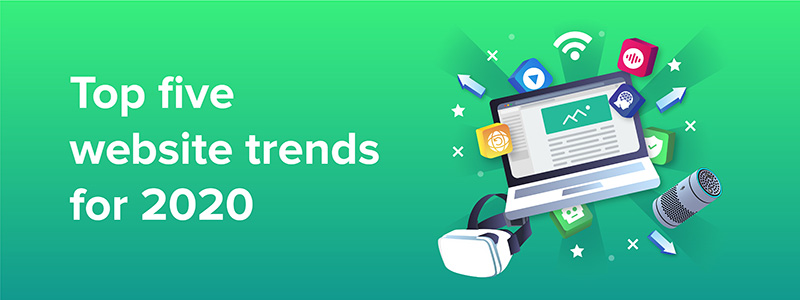Top Five Website Trends for 2020

The new year is fast approaching, and many of us will make resolutions in preparation for 2020. As you make your own personal pledge to change an undesired trait or behavior, or to accomplish a personal improvement goal, take a closer look at some of the changes you can make on the business side of things. Perhaps your organization’s websites could use some improvements of their own.
Looking at website trends is a good place to start, but with new technology advancements being revealed on a near-daily basis, keeping up with industry developments can be tedious. Are you wondering how to grab a glimpse of the trends for the coming year and beyond? We’ve made things easy for you: here are the top five website trends expected in 2020.
1. Augmented reality (AR)
AR is a perfect amalgamation of the digital world and physical elements, helping to create an artificial environment that, in the case of online shopping sites, helps customers zero in on merchandise. For instance, the “Scan” option of the Nike app can evaluate a customer’s foot size to recommend the most suitable shoe type or pattern. This offers customers a more realistic brick-and-mortar shopping experience, including being able to virtually "try on'' a pair of shoes.
In the near future, AR will be used more frequently in smartphone apps, desktop sites, and mobile sites, from applying filters to images, to trying on clothes, and for other unique purposes. AR will introduce new dimensions to the user experience in 2020. According to a 2018 Gartner survey, 46 percent of retailers plan to integrate AR technology into their shopping experience by 2020.
2. Video-centric content
Users are going to hang around your website for less than 15 seconds, so you have little time to grab their attention. Studies prove that a human brain can process images 60,000 times faster than text. So a short, crisp video is the best bait you can offer, and that’s why video content will continue to be the soul of websites in 2020.
Grab customers’ attention, convey your message in a light, breezy manner, and help them to learn about your product without any hassle. Videos are predicted to garner a major share of web traffic, approximately 80 percent, in 2020. With more than 500 million hours of YouTube videos watched every day, video-centric content will revolutionize the digital experience offered by websites. Landing pages, feature pages, and blogs will feature more and more videos in the coming years.
3. Voice user interfaces (VUIs)
VUIs are visual, auditory, and tactile interfaces that enable voice interaction between people and devices. They use speech recognition to enable users to interact with technology using their voice. A VUI can be anything from a light that blinks when it hears a voice, to an automobile’s entertainment console. With Alexa, Siri, and Google Assistant making lives easier across the globe, VUIs becoming "the thing" in 2020 is not an unexpected twist.
VUIs can enhance the user experience by making navigation and online shopping experiences more personal and easy. A VUI enables hands-free, efficient interactions that are more "human" in nature. Implementation of VUI-based technology is a major landmark in our journey towards human-centric technology advancements. As per a ComScore survey, 50 percent of all searches will be voice searches by 2020.
4. Artificial intelligence (AI)
AI is already transforming modern web design and making human-machine interactions easier by bridging the gap between human cognition and machine automation. Chatbots, an inevitable component of most future websites and mobile applications, is a progeny of AI. Gartner predicts that 85 percent of customer interactions will be handled by AI chatbots by 2020.
AI can bring in a human element to enhance user experiences. By 2020, websites that cater to the personalized needs of customers are projected to become more popular than a something-for-everyone website. For instance, Netflix uses AI to provide recommendations based on the user preferences of similar customers. Websites are expected to be more conversational from the influence of AI. AI can also be helpful in lowering costs through automation.
5. Cybersecurity
Ensuring a secure cyberspace is going to be a major concern in 2020. With nations across the globe adopting new policy guidelines, cybersecurity will be the focus of most discussions and on the minds of customers as they interact with your website. With cyberthreats popping up in different forms and inflicting damage on businesses, industries, supply chains, and government operations, security experts expect AI and cloud-based technologies to provide solutions.
AI is predicted to eliminate time-consuming research tasks and provide in-depth analysis of risks, thereby reducing the amount of time security analysts will require to make critical decisions. Cloud-based cybersecurity systems, built with open APIs, can easily integrate with many devices; this in turn helps manage vast amounts of data. Like cloud-based services, cloud-based security systems are scalable, easily installable, and flexible in terms of device and location restrictions. AI and cloud-based cybersecurity can help shield organizations from new forms of cyberthreats that might appear in 2020.
Apart from these trends, more widespread mobile usability, accessibility, use of 3D models, etc. are also predicted to revolutionize web design. Remember, it just takes 50 milliseconds for a user to form an opinion about your website. Gear up your website now to provide an enriching user experience in 2020. With websites adapting AR/VR, AI or VUI they will be more dynamic thereby enhancing the digital experience, which in turn can increase the time customers spend on your site. But when more number of elements are added to your website, it is crucial to ensure uninterrupted performance and availability; which can be done by using an all-in-one monitoring tool like Site24x7.